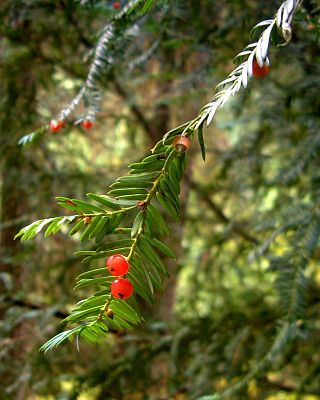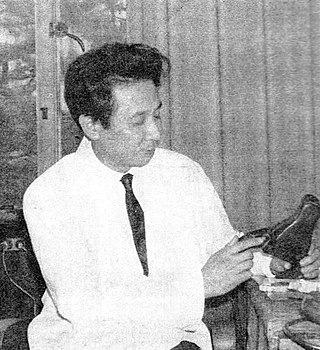Related Research Articles
The following outline is provided as an overview of and topical guide to chemistry:

Organic chemistry is a subdiscipline within chemistry involving the scientific study of the structure, properties, and reactions of organic compounds and organic materials, i.e., matter in its various forms that contain carbon atoms. Study of structure determines their structural formula. Study of properties includes physical and chemical properties, and evaluation of chemical reactivity to understand their behavior. The study of organic reactions includes the chemical synthesis of natural products, drugs, and polymers, and study of individual organic molecules in the laboratory and via theoretical study.
Physical science is a branch of natural science that studies non-living systems, in contrast to life science. It in turn has many branches, each referred to as a "physical science", together is called the "physical sciences".
Combinatorial chemistry comprises chemical synthetic methods that make it possible to prepare a large number of compounds in a single process. These compound libraries can be made as mixtures, sets of individual compounds or chemical structures generated by computer software. Combinatorial chemistry can be used for the synthesis of small molecules and for peptides.

In organic chemistry, acetyl is a functional group with the chemical formula −COCH3 and the structure −C(=O)−CH3. It is sometimes represented by the symbol Ac. In IUPAC nomenclature, acetyl is called ethanoyl.

Biochemists are scientists who are trained in biochemistry. They study chemical processes and chemical transformations in living organisms. Biochemists study DNA, proteins and cell parts. The word "biochemist" is a portmanteau of "biological chemist."

Medicinal or pharmaceutical chemistry is a scientific discipline at the intersection of chemistry and pharmacy involved with designing and developing pharmaceutical drugs. Medicinal chemistry involves the identification, synthesis and development of new chemical entities suitable for therapeutic use. It also includes the study of existing drugs, their biological properties, and their quantitative structure-activity relationships (QSAR).

A natural product is a natural compound or substance produced by a living organism—that is, found in nature. In the broadest sense, natural products include any substance produced by life. Natural products can also be prepared by chemical synthesis and have played a central role in the development of the field of organic chemistry by providing challenging synthetic targets. The term natural product has also been extended for commercial purposes to refer to cosmetics, dietary supplements, and foods produced from natural sources without added artificial ingredients.

Chemical biology is a scientific discipline between the fields of chemistry and biology. The discipline involves the application of chemical techniques, analysis, and often small molecules produced through synthetic chemistry, to the study and manipulation of biological systems. Although often confused with biochemistry, which studies the chemistry of biomolecules and regulation of biochemical pathways within and between cells, chemical biology remains distinct by focusing on the application of chemical tools to address biological questions.

Dmitrii G. Knorre was a chemist and biochemist, a specialist in chemical kinetics of complex reactions, bioorganic chemistry, and molecular biology. He was a Corresponding member of the Academy of Sciences of the USSR since 1968, and an academician since 1981. He was assigned to the Division of Biochemistry, Biophysics, and Chemistry of Physiologically Active Compounds of the Academy and to the Siberian Division since 1981.
The National Academy of Sciences Award in Chemical Sciences is awarded for innovative research in the chemical sciences that in the broadest sense contributes to a better understanding of the natural sciences and to the benefit of humanity.
The Willard Gibbs Award, presented by the Chicago Section of the American Chemical Society, was established in 1910 by William A. Converse (1862–1940), a former Chairman and Secretary of the Chicago Section of the society and named for Professor Josiah Willard Gibbs (1839–1903) of Yale University. Gibbs, whose formulation of the Phase Rule founded a new science, is considered by many to be the only American-born scientist whose discoveries are as fundamental in nature as those of Newton and Galileo.
A chemical library or compound library is a collection of stored chemicals usually used ultimately in high-throughput screening or industrial manufacture. The chemical library can consist in simple terms of a series of stored chemicals. Each chemical has associated information stored in some kind of database with information such as the chemical structure, purity, quantity, and physiochemical characteristics of the compound.

Koji Nakanishi was a Japanese chemist who studied bioorganic chemistry and natural products. He served as Centennial Professor of Chemistry and chair of the Chemistry Department at Columbia University.

JoAnne Stubbe is an American chemist best known for her work on ribonucleotide reductases, for which she was awarded the National Medal of Science in 2009. In 2017, she retired as a Professor of Chemistry and Biology at the Massachusetts Institute of Technology.

Institute of Chemical Process Fundamentals, Academy of Sciences of the Czech Republic, v.v.i. is one of the six institutes belonging to the CAS chemical sciences section and is a research centre in a variety of fields such as chemistry, biochemistry, catalysis and environment.

Bogumił Kazimierz Brzezinski is a Polish chemist, professor of chemistry science who specialises in the field of infrared spectroscopy and hydrogen bonds. Co-worker of Prof. Georg Zundel. He is co-author of nearly 400 original scientific publications.
The following outline is provided as an overview of and topical guide to natural science:

Institute of Organic Chemistry and Biochemistry of the Czech Academy of Sciences is a research institute under the Czech Academy of Sciences (CAS). The institute centers around research in the fields of organic chemistry, biochemistry and neighboring disciplines, mostly oriented at applications in medicine and environment. It is known for its contribution in the development of key drugs against HIV and HBV. The institute also takes part in university education, supervising master's and doctoral theses.
References
- ↑ Schmuck, Carsten, ed. lit. Wennemers, Helma, ed. lit. (2004). Highlights in bioorganic chemistry : methods and applications. Wiley-VCH. ISBN 3-527-30656-0. OCLC 782820192.
{{cite book}}: CS1 maint: multiple names: authors list (link) - 1 2 Breslow, Ronald (June 1998). "Bioorganic Chemistry: A Natural and Unnatural Science". Journal of Chemical Education. 75 (6): 705. Bibcode:1998JChEd..75..705B. doi:10.1021/ed075p705. ISSN 0021-9584.
- ↑ Nelson J. Leonard, Bioorganic chemistry-a scientific endeavour in continuous transition Pure Appl. Chem., Vol. 66, No. 4, pp. 659-662.